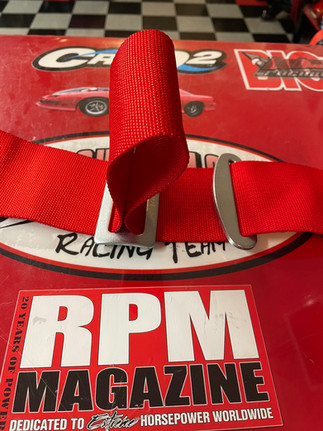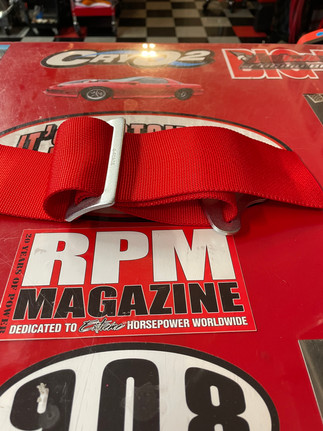SHOP TALK: Safety First
Special Note: There will be a Part 2 of this feature that will cover helmet and suit safety.
Hello my fellow gearheads. With winter finally behind us, you should be fully enjoying whatever your passion is with horsepower. The term “upgrade” implies to improve or to better something. In my Shop Talk column, it usually has to do with making more power, making something stronger, or finding a way to save some weight. This month please allow me to talk about making things safer. I have heard people say this, and I not only say it, but believe it – “If I die racing my car, at least I went out doing something I am passionate about and live for.” Now I am willing to bet that 100% of you that just read that agree with me whole heartedly. Let’s take a step back and break this down to what really matters. Can we all agree that dying is not a good thing? Not to mention a sudden or unexpected death leaves your family with many questions and trauma. Besides, what will they do with your car and all of your tools? That is the real trauma.
Unfortunately, the faster we make our cars, the more dangerous they become. Here is where most weekend enthusiasts make bad decisions. Situations like knowing your Uncle Ted has some scrap metal lying around his property and could weld you up a roll cage with his stick welder in a weekend. No disrespect to your Uncle Ted, but he is an accountant during the day. The old metal fencing he has laying around his property and the stick welder he found at garage sale are not going to help you at all when you hit the guard rail. In fact it has been proven that a poorly built roll cage is even more deadly than not having one. Imagine you are now surrounded with poorly welded pieces of metal that form extremely sharp edges upon breaking. These sharp pieces of metal become amazing projectiles that will most certainly give your family something to remember you by.

If you are thinking of getting a roll cage made for your car, make sure it meets all the criteria needed to compete in whatever sanctioning body you are racing in. If your sanctioning body does not have any guidelines, please visit the SFI website and found out what you need. Your next step is to use quality material whether it is mild steel or chromoly. Whatever you choose, make sure it meets the standards of your required certification. The last but most important step is to have it fabricated by a real fabricator, not an accountant that welds on the weekends. I know it will cost more money but life is priceless. The tools that are necessary to build a custom roll cage are extremely expensive, not to mention the years of experience and expertise a seasoned fabricator brings into the mix. To be fair, just because your fabricator’s Uncle Bob is good with numbers doesn’t mean he should get his shops taxes done by him, even though he has a real adding machine. He should be using your Uncle Ted.
This takes us to another important part of your car that needs safety certification. Your seatbelts or safety harness. The SFI website has some really informative information on safety belts and how long they last. After reviewing years of actual data they have deemed it mandatory to have your belts re-certified every two years. I have worked closely with the amazing people at G-Force Racing Gear ever since I began building Big Red. Their products are held to the highest safety standards. I had a unique opportunity to meet with every major harness manufacturer at SEMA one year and not only learned a lot about harnesses, but about the company’s vision and overall customer service. At the end of the day I was convinced that I was going to partner with G-Force Racing Gear and trust them with keeping me safe. Besides choosing the harness that best meets your needs and safety requirements, a common mistake I encounter most frequently are most people don’t know how to properly secure their harness to their cage. I will include some photos of the steps necessary to correctly web a harness.
The next level of safety takes me to the quick release steering wheel. Most people think its sole purpose is to help us get in and out of our car easier as we get older and wider. While this may be true to some extent, it is not the important reason. Steering columns are designed to crush and absorb impact so the column does not push forward into the driver and crush their chest. If yours does not, please look into this slight problem you may face. The quick release enables a first responder to gain more access to you without the use of cutting tools. Not all quick releases are the same and quite honestly some are extremely dangerous. I have heard my share of stories from racers whose steering wheels came off while racing.
You should not overlook a quality window net as well. Like I mentioned before G-Force Racing has everything you need for safety including window nets. There are many ways to attach a net to your vehicle, but in my opinion Tim McCamis has perfected the design. His system is not only stronger, but easier for the first responder to work with. Do yourself a favor and watch the video he made on this subject. (https://www.youtube.com/watch?v=Ii9rfBqSLGQ) A window net will not only keep you inside in the event of losing your window or door, but it will also keep large objects from coming inside the cockpit.

When it comes to fire suppression, hopefully all of you have at least a small fire extinguisher that is safely mounted and in arm’s distance from the driver’s seat. I recently witnessed a friend’s car burn to the ground because he could not get out of his vehicle fast enough to put the engine fire out. I cried with him as he not only lost his pride and joy, but a fortune of hard earned money and sacrifice. I had a small extinguisher mounted on my roll cage, but after that I decided to purchase a fire suppression system. Before you get scared of that fancy term and relate it to being expensive, I assure you they make systems from single nozzles all the way to 8 nozzles and more. I have an extremely limited budget and found a system for just over $200 that gave me 2 nozzles, a 2.25 liter bottle, and all of the hardware necessary to make it work. I wanted my bottle to mount to my cage and found a quick release system that attaches one side of the bracket to my cage and the other to the bottle. I had a friend who owed me some money for a wiring job I did for him, and he gave me a single nozzle system and another 2.25 liter bottle as payment. I use the 2-nozzle system for the engine bay and mounted the nozzles on each side of the engine. The single nozzle system I have mounted on the cockpit facing me. I have two handles to choose from so if there is an engine fire, I do not have to make a mess in my interior and vice versa. This safety feature is very easy to install and extremely affordable. I even told my brother that I will not do any more fabrication on his custom mud truck unless he agrees to purchase one.
The last bit of safety I want to discuss in this article is your clothing. A fire suit may be hot and heavy, but burning to death is far worse. Make sure you do not make your purchase based on money. Get a fire suit that will protect you. Also get fire retardant undergarments in the process. One more layer of protection will give you more time in the event you need it. Helmets, gloves, and neck braces should not be overlooked or purchased simply because they look cool. Take the time and research this area and find the products that will protect you, not make you look cool.
You already know you shouldn’t run with scissors in your hand or touch a hot stove. That old saying, “safety first” should come first before you line up against someone with your ride. Be smart and be safe. Live to race another day.
Until then – Keep wrenching,
JT






































Commentaires